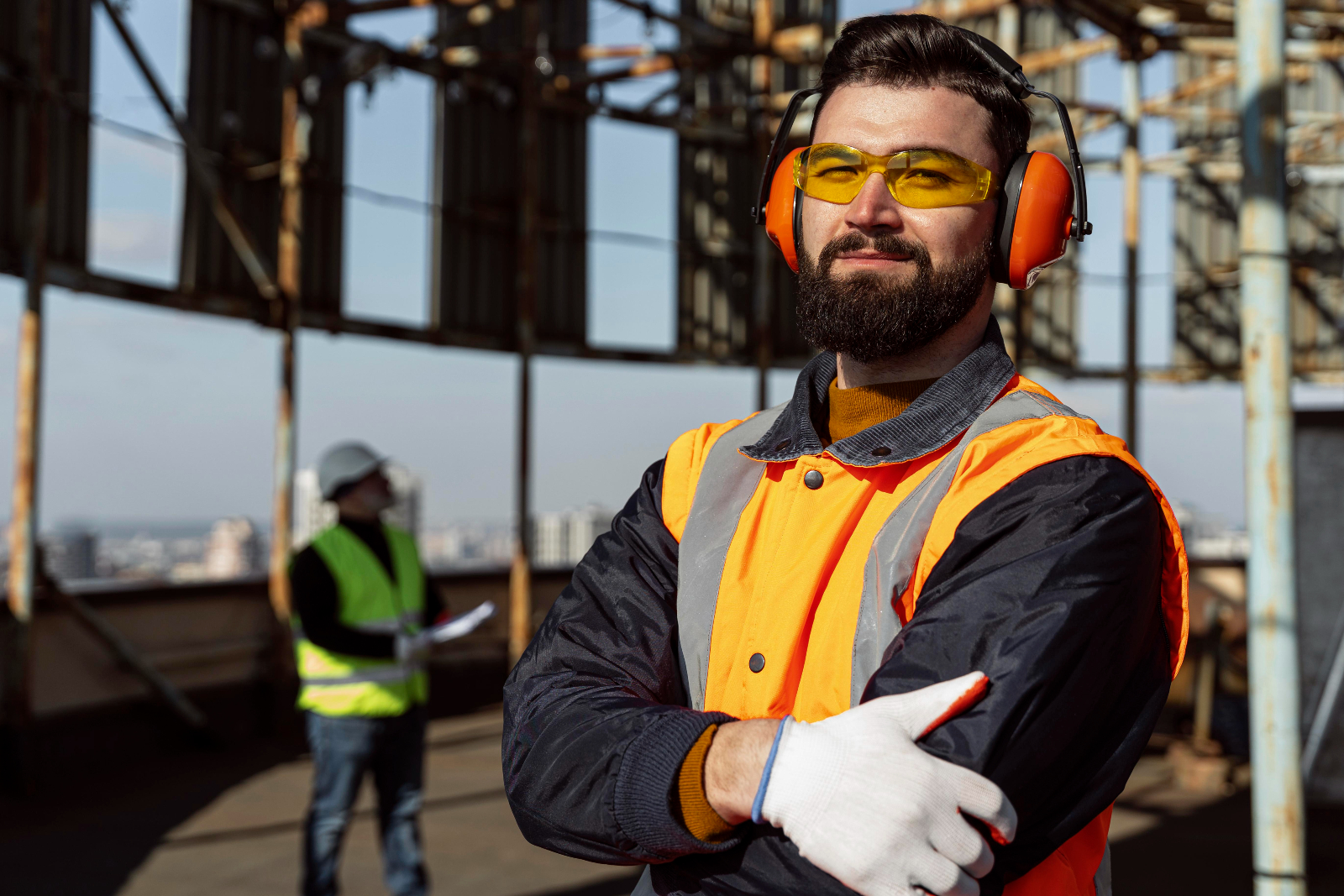
With tools and equipment in almost constant use, a construction site is generally a noisy environment.
Aside from the potential for this to cause nuisance to neighbouring communities, frequent exposure to raised noise levels can have serious consequences for workers, causing problems like tinnitus (a sensation of ringing in the ears) and hearing loss.
Find out more, including how to protect yourself from these risks in this week’s blog.
Know the risks
If construction workers are experiencing difficulties with their hearing, there are some immediate short-term risks to consider. For instance, they may not be able to hear the sounds of machinery or communicate effectively with co-workers (both of which could increase the chance of an accident occurring on site).
Longer term, the risks can be even more serious as exposure to loud noise over a working life in construction can lead to more significant and in some cases permanent hearing loss. Once that happens, there is no cure and this can have a profound impact on the quality of life of the person affected.
Another common effect of being exposed to loud noise is tinnitus. People with this condition experience a sensation of ringing in their ears, ranging from a faint ringing to a painful sound.
What you should do
Like any health and safety issue in construction, there is legislation which states that practises should be in place to prevent or reduce risks from exposure to noise at work along with clear guidelines from the Health and Safety Executive about how to go about this. Here’s a 3 step approach:
1. Identify and assess
With all kinds of noisy activities occurring at the same time on a construction site, there’s a lot to consider at this stage.
Start by identifying WHO is most at risk. This will include workers who regularly use or work near power tools like concrete breakers, sanders, grinders and disc cutters as well as those who operate or work close to heavy plant machinery. Make sure to give particular consideration to anyone who is known to have an existing hearing problem.
Next, think about WHAT kind of noise exposure comes from the tasks you are doing. As a simple guide you will probably have to do something about noise if workers:
- Have to raise their voices when talking while about 2 metres apart for at least part of the working day.
- Use noisy powered tools or machinery for more than half an hour each day.
- Are exposed to noise from regular impacts, such as pneumatic drills, or explosive sources like cartridge-operated tools.
Another thing to identify and assess is WHERE the work-related noise takes place. Enclosed spaces can be more harmful because noise is reflected back from walls, increasing the exposure levels.
2. Prevent
The most effective way of preventing noise associated health risks is to eliminate or reduce the source of the noise. This might involve:
- Eliminating unnecessary noisy tasks at the design stage.
- Using alternative processes that do not generate as much noise, for example:
- block splitters instead of cut-off saws
- bursting or crushing instead of pneumatic drilling
- boring instead of pile driving
- limiting vehicle reversing on site (reversing alarms add to the total noise on a site).
- Isolating workers from noisy tasks by keeping doors and windows of vehicle cabins closed or using remote controlled equipment.
- Shutting down equipment, like vehicles, when they are not in use.
- Using and maintaining equipment correctly. When in use, make sure devices like silencers, mufflers or covers are in place and working correctly. Maintain equipment regularly so as to prevent additional noise that arises from loose and worn parts.
3. Control
Even with the best preventative practices in place, a construction site is never going to be the quietest of workplaces so the third step is to take measures which control the risk.
- Equipment – Select low-noise tools and equipment wherever possible. Existing equipment can also be modified to reduce the noise it makes (e.g. through silencers on exhausts and sound panels on engines).
- Work practices – Make sure to follow manufacturers’’ guidelines on equipment and give a little bit of thought to any kind of noise impact. For instance, just making sure the doors and windows of cabin vehicles are closed will reduce noise exposure for the operator).
- Sound barriers – Stop noise escaping by using temporary shields/ sound barriers. Use existing objects such as trailers or cabins to stop noise travelling. Common construction materials like plywood or another sound absorbing material can be used to make temporary barriers or enclosures.
- Noise exclusion zones – Limit access to noisy areas to only those workers who must be there to complete their tasks.
- Distance – Noise levels drop significantly with distance so try to position stationary noise sources as far as possible from workers. Locate walkways away from noisy tasks.
- Rotate workers – Limit the time workers are exposed to noise. You can use a ‘Weekly averaging’ approach to manage exposure and try to schedule ‘quiet days’ for everyone.
- Hearing protection – Hearing protection is an important method of control but this should never be seen as an alternative to eliminating and reducing noise at source. Hearing protection can easily fail or be misused and remember that overprotection can also be hazardous. Workers need to be able to hear what is happening around them on construction sites to avoid accidents and to communicate with each other!
- Monitor hearing health: Appropriate and regular hearing checks should be carried out if workers are frequently exposed above the upper noise action value (set at a daily or average weekly exposure of 85 decibels) or they are at particular risk (e.g. they already suffer from hearing loss issues). If these checks identify a problem, current noise controls should be reviewed and improvements made wherever possible. Action should also be taken to specifically prevent further harm to the person concerned.
Research suggests that nearly two million of the 12 million UK adults who are suffering from hearing loss are likely to have had their hearing impaired because of exposure to harmful noise at work.
In several critical industries the problem is particularly serious and this includes the construction sector. Academic surveys suggest that one in four noise-exposed construction workers have a significant hearing impairment, and seven percent of all construction workers have tinnitus.
Let’s ensure our team do not become one of these statistics and do all that is necessary to Identify, Prevent and Control those noise risks on site.
14.08.2023
Feature image: Freepik








